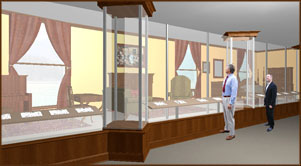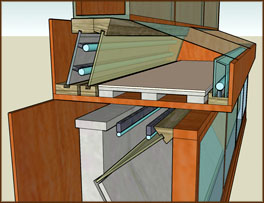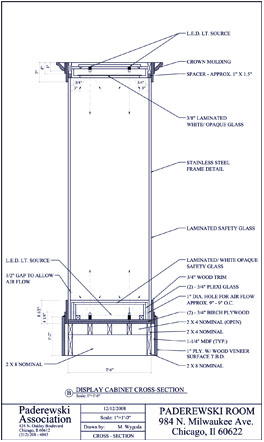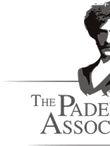The
Paderewski Room Display Design

Image credit: Agnes Otworowski, computer rendition of the
elevated section of the room, based on CAD drawings
The design of the Paderewski Room Display was developed to preserve the Maestro’s possessions which were granted to Chicago’s Polish Museum of America, shortly after his death in 1941. The Museum’s director, Mieczyslaw Haiman, gladly received this property by Paderewski’s sister Antonina. Among the entrusted objects were Paderewski’s last practice Steinway piano, the pen that Paderewski used to sign the Versailles Treaty, jewelry, letters, documents, every day use objects and furnishings of his last living place, the suite at the Buckingham Hotel in New York city.
The Paderewski Association presented the display design development proposal in 2008 to the PMA. The ultimate goal of this project was to ensure proper safety and security of all the artifacts according to the highest levels of archival standards as well as to preserve the room’s original architectural artwork from 1937.
The design proposal included the following
recommendations:
- To establish a complete collection inventory along with a comprehensive conservation plan and exhibition options.
- The historic display cabinets be fitted with archival frames, mounting systems, safe LED and UV protective lighting distribution, and environmental monitoring elements without altering the beauty of original millwork.
- The room’s plaster crown moldings be repaired where necessary and finished to match the existing composition, texture and color.
- Areas of decorative ceiling murals and stencil work where plaster and paint were lost, would be conserved and in-painted.
- The implementation of new technologies such as projected digital imagery, sound and light, to be carefully designed and integrated to enhance the interpretation of the collection.
- The overall design proposal outlined the requirements of proper
monitoring for theft,
fire, humidity and temperature.
the generosity of professionals who performed their
work at reduced rates or donated their time free of
charge. We would like to express our gratitude
especially to Dr. Bronislaw Orawiec, M.D. for
a generous donation, and to all the Polish and
American artists and artisans who donated their
works during our three annual fund raising auctions
“Luxuries Befitting a Maestro” in 2006, 2007 and
2008, the volunteers who worked tirelessly
with auction logistics, and the PMA staff.

Image credit: Agnes Otworowski, computer rendition of the original historic display cabinet crossection with archival lighting and membranes implementation, based on CAD drawings
DESIGN CREDITS:
Dennis Novak, interior and display design
Margaret Wygoda, CAD drawings
Agnes Otworowski, computer renderings based on CAD drawings
Andrzej Dajnowski, preservation consulting
Stan Bernacki, project coordinator
Ron Steinberg, digital display consulting
Jerzy Chlopek, upholstery conservation consulting

The image indicates the placement of LED light source, laminated white opaque safety glass layer preventing the display area from direct light exposure, and openings for air flow.

